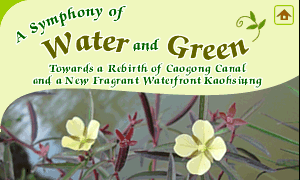Teacher Mr. Wen-chien Cheng is the director of Fong Shan Literature & History Studio. He has promoted several local researches and educational programs, almost everyone in the FengShan area knows about him. During this visit, he personally took us to the Caogong Canal, and we truly understood the problems it faced. The following is our interview with Mr. Cheng: |
Q¡GWhy is your work focused on Caogong Canal¡H |
A¡GThat's because Caogong Canal involves so many areas, such as human science, geography, natural habitats, farming and related watering facilities. This important project needs the commitment of all Kaohsiung citizens, which constitutes 10% of the Taiwan population. I hope Caogong Canal can have a better standing in the course of our history. During the past 170 years, Caogong Canal has served farmland-watering functions; yet agriculture competition is fierce now, and today Caogong Canal is looked upon just as an asset of culture. |
Q¡GHow long have you been studying Caogong Canal¡H |
A¡GI began this root-searching journey in 1999, and visited the homeland of Caogong¡ÐHaNoi county in China, for at least five times before 2005. These experiences provided me with precious data for my further research. |
Q¡GWhat kind of problem is Caogong Canal facing now? |
A¡GThe main problem is that everyone takes water resources for granted. Little do they know that Caogong Canal does not just serve as an agricultural watering facility, it can change our quality of life if we reconstruct it into a wetland scenery park or an educational location for ecosystem related knowledge. |
Q¡GCould you explain to us the transformational process of Caogong Canal¡H |
A¡GThis process can be divided into four parts:
The first phase: 170 years ago, when Caogong elevated the water level, and drained the water into the farm fields. He used a contour line of 20 meters to lead the water to all parts of the Kaohsiung plane.
The second phase: Dams had to be constructed annually, which used up too much labor. Now, motors are employed to pump up underground water
The third phase: The amount of water usage was approximately assesed in the past. Now they use computers to calculate the exact amount of water for watering the fields.
The fourth phase: Local residents have to learn how to take care of this little river, and prevent it from becoming a smelly gutter. If this is successful, there will be a lot of change for Caogong Canal.
|
Q¡GWhat are your plans for upgrading Caogong Canal into a river? |
A¡GCaogong Canal should not just serve field watering and flooding drainage functions. Our new idea for Caogong Canal is to develop water activities in gentle areas of water flow. For instance, visitors can row boats and listen to songs or tell stories while they spend time there, and this will boost the tourist business here. Perhaps we can make it look just like the canals of Venice. Residents there will feel the difference when Caogong Canal radiates beauty for the community; this is consistent with the idea of stressing individuality for different living areas. We can achieve this goal if we fully use the things this river can provide us. |
Q¡GHow is Caogong Canal going to be preserved and develop in the long run? |
A¡GIf Caogong Canal wants to survive in the end, it will still have to serve its watering functions, but the thing that needs working on is its cultural value and further development. 170 years of history is valuable, but there is more underlying potential that we have overlooked; it can be a habitat for animals, assist agriculture and water technologies, or be a source of knowledge for education. We should gradually achieve this goal and bring out the true functions it can perform. |
Q¡GWhere is the future for Caogong Canal development? |
A¡GThe future for Caogong Canal development should closely relate to the people and the land. By leading fresh water inward, the people will understand the importance of Caogong Canal. What would happen if Kaohsiung did not have Caogong Canal? Devastating effect will occur. The clarity of all rivers, such as love river, Cianjhen River, Hojin Creek would decrease. In addition, if no water was imported, the fields would dry up, and crops would not grow successfully. Without Caogong Canal, our underground water levels would decrease and seawater would contaminate our fresh water supply. That is why the conservation of Caogong Canal is related to various problems that affect our lives. |
Q¡GWhy are the Kaohsiung city and Kaohsiung county development projects going exactly the opposite direction? |
A¡GNot exactly the opposite, because this issue will gradually gain more emphasis in the future, it's just a matter of time. The rebirth of Caogong Canal should be a goal the Kaohsiung government and environmental groups will work on in the future. We hope everyone can gradually understand the importance of this issue, and speed up the process; and you, as the next generation, bear great responsibilities for fulfilling this legacy! |
Reflection

The efforts Mr. Cheng has put into the research of Caogong Canal and its rebirth projects is immense. Without a person like him, our government and society won't look into these projects and value their importance. We hope Kaohsiung city and Kaohsiung county will soon cooperate to reconstruct Caogong Canal and transform it into a beautiful scenery site of Kaohsiung. |

